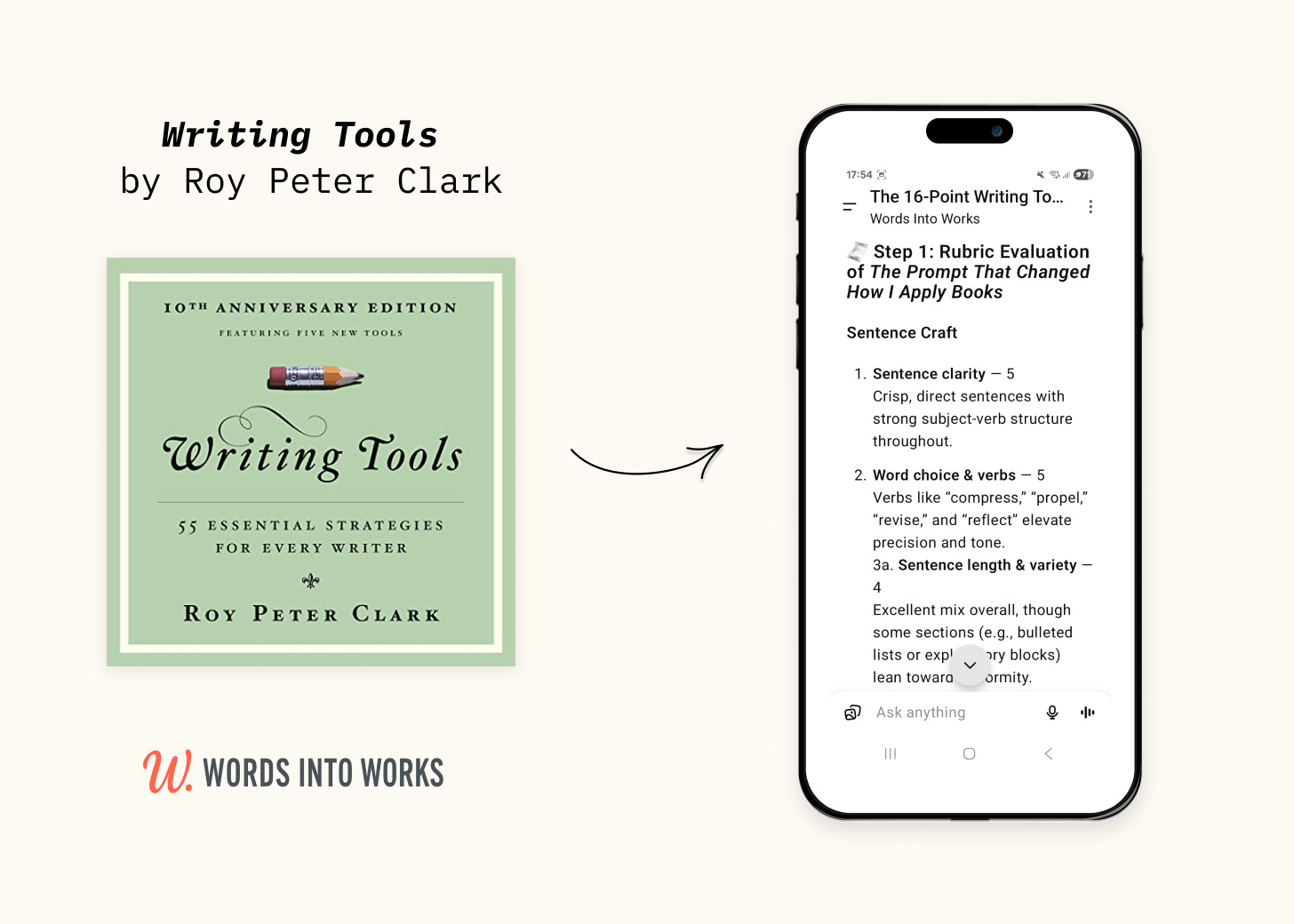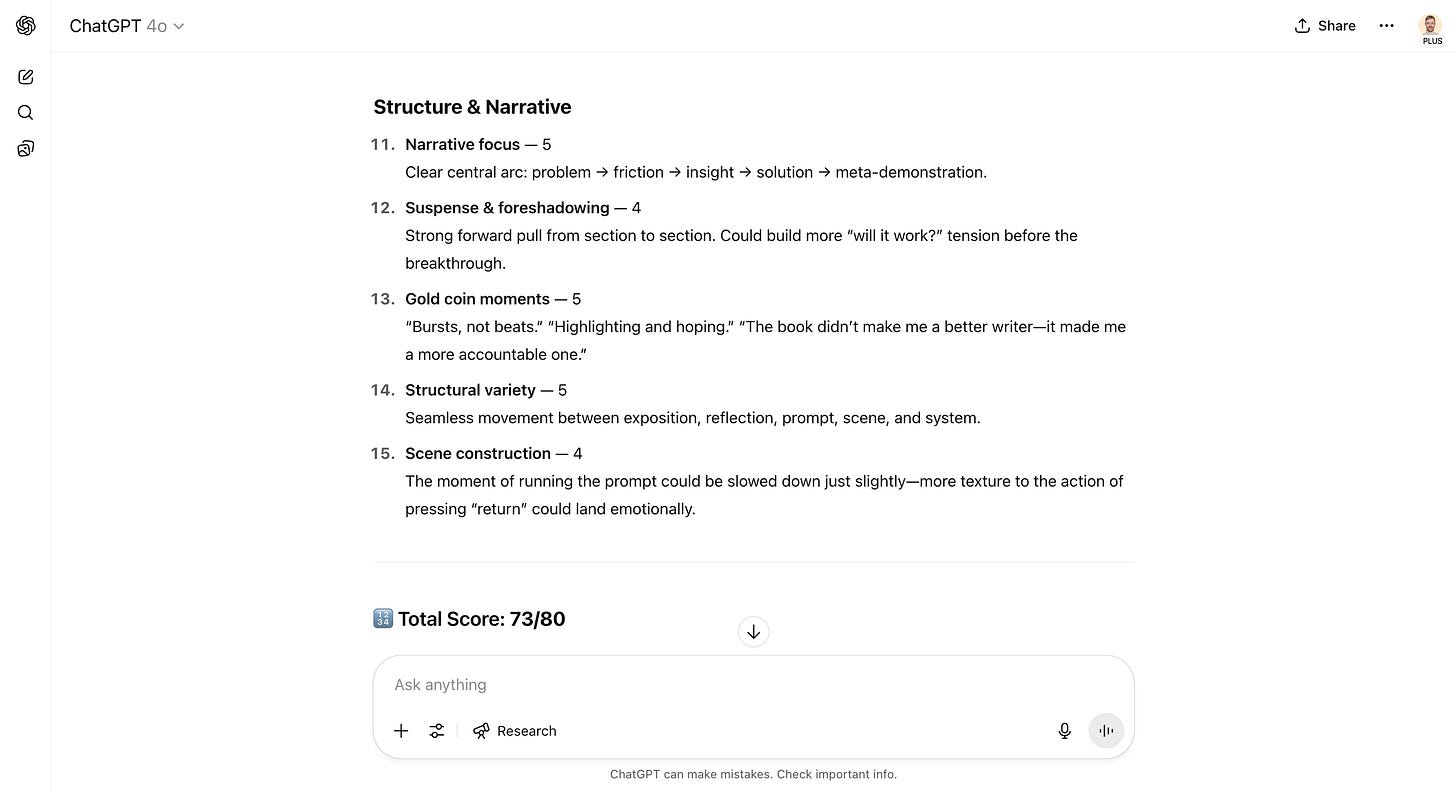Turn Any Draft Into Polished Prose With This 4-Step Prompt
How I Turned Roy Peter Clark's 55 “Writing Tools” Into a 4-Step Prompt
Welcome to Words Into Works. Each week, I share one article that helps you use AI to apply what you learn from nonfiction books. If you’ve ever finished a great book—and struggled to do something with it—this newsletter is for you. Paid subscribers gain full access to every prompt, walkthrough, and live example I’m creating to help turn ideas into action.
TL;DR
Most people read writing books, highlight the best tips, and hope they stick. I used to do the same—until I realized I didn’t need more advice. I needed a mirror. This issue shares how I turned Roy Peter Clark’s Writing Tools into a live writing coach using ChatGPT and built a 16-point rubric that identifies what’s working, what’s not, and how to improve it.
For a long time, I treated writing books like they came with a guarantee. Highlight the insights. Follow the steps. Better writing, automatically.
So, when I finished Roy Peter Clark’s Writing Tools, I did what I always did: I summarized the tips, saved them in Notion, and told myself I’d review them before every draft.
But when I actually sat down to write, something strange kept happening.
I’d remember one or two tools—maybe “start with strong verbs” or “vary sentence length”—but forget the rest.
I’d scan my sentences like a student cramming before a test, hoping the right patterns would jump out.
They rarely did.
Eventually, I had to admit it: I wasn’t applying what I’d learned. And I wasn’t improving.
That’s when I stopped treating the book like a manual and started using it like a coach.
The Shift That Changed Everything
The first time I tried to apply Writing Tools, I had two tabs open—one with my newsletter draft, the other with my carefully organized summary of all 37 tips.
I told myself, “Let’s see which ones I’ve used.” But within minutes, I was stuck.
Some tools overlapped. Others contradicted each other. A few were so subtle, I wasn’t even sure what to look for.
What looked like guidance turned out to be guesswork in disguise.
I realized I didn’t need more information. I needed traction, something to grip when the sentence slipped.
So, I started building something better.
I started by distilling all 55 tools, focusing on the ones in Parts 1–3, where most of the sentence-level magic lives.
Thenm I added examples—just a line or two each—to make the abstract advice visible on the page.
Next, I turned the summary into a writing prompt, one I could paste into ChatGPT to evaluate my draft.
Each step helped. But it still felt like I was dragging the entire book behind me. So, finally, I compressed everything into a 16-point rubric, grouped into three tiers:
Sentence Craft (clarity, verbs, rhythm, pacing)
Style & Voice (tone, surprise, specificity)
Structure & Narrative (focus, momentum, emotional payoff)
It didn’t hand out a grade. It handed back the page with the lights still on.
That’s when Writing Tools stopped feeling like a checklist and started acting like a coach.
Try the Prompt for Yourself
If you’re curious how this actually works, here’s the exact prompt I use inside ChatGPT whenever I want to test a draft against the standard set by Writing Tools.
It doesn’t just give you a score. It helps you see where the writing holds, and where it slips.
You are a world-class writing coach trained in Roy Peter Clark’s Writing Tools. Your task is to score a piece of writing using a 16-point rubric based on Tools 1–37, then offer constructive, actionable feedback.
🔽 When I paste a piece of writing, follow this process:
Step 1: Score the Text Using the Rubric Below
Use a 0–5 scale for each of the 16 criteria. Each item reflects a key tool or cluster of tools from _Writing Tools_ by Roy Peter Clark. Add short comments for any score below 4.
Writing Tools Rubric (16 Criteria)
Sentence Craft
1. Sentence clarity — Begins with strong subjects and verbs; avoids muddy constructions.
2. Word choice & verbs — Uses precise, vivid verbs; avoids weak modifiers.
3a. Sentence length & variety — Mixes short and long sentences to control pace and emphasis.
3b. Cadence & momentum — Builds rhythmic flow; uses transitions and sonic structure to propel prose.
4. Concision — Avoids redundancy, filler, or vague abstraction.
5. Concrete detail — Uses vivid, specific nouns and grounded imagery.
Style & Voice
6. Voice alignment — Matches tone to purpose, audience, and subject.
7. Originality — Avoids cliché; uses fresh metaphors, phrasing, and structure.
8. Play & surprise — Uses contrast, juxtaposition, or pattern disruption to sustain interest.
9. Dialogue & character — Reveals personality or tension through voice or behavior.
10. Abstraction control — Moves skillfully between general ideas and specific scenes or examples.
Structure & Narrative
11. Narrative focus — Centers on a core question, conflict, or theme.
12. Suspense & foreshadowing — Uses tension, curiosity, or clues to build anticipation.
13. Gold coin moments — Provides insightful, resonant, or emotionally satisfying turns.
14. Structural variety — Weaves together scene, exposition, reflection, and action.
15. Scene construction — Shows moments in real time with action and detail.
Step 2: Identify Opportunities for Improvement
List the top 3 scoring criteria under 5, and provide 1–2 sentences of practical revision advice for each.
Step 3: Suggest Specific Rewrites
Choose 1–2 small passages (up to 3 sentences total) from the original that exemplify an area for improvement. Rewrite them using specific tools and name which ones you’re applying.
Final Step: Ask for My Preferred Revision Path
Ask me:
Which approach would you like to take next?
(1) Implement the top three suggestions, one at a time, pausing for your feedback before moving forward
or
(2) Work through each rubric category in order, aiming to bring each to a 5/5.
(Skip any category that already scores 5/5.)
Then wait for my response before continuing.
How This Issue Got Better
This issue—the one you’re reading—was shaped by the very prompt it shares. I ran the first draft through the 16-point rubric. It gave me a score of 73 out of 80.
But more than a number, it gave me a mirror. Said another way, it showed me where the writing held, and where it slipped.
One moment stood out in particular. In an early version, the rhythm fell flat in a list-heavy section.
It read:
Some tools overlapped. Some contradicted each other. Some were hard to spot without a microscope.
Now it reads:
Some overlapped. Some contradicted each other. Others were so subtle, I’d need a microscope to find them.
Small shift. Better flow. More variation. Less friction.
Elsewhere, I replaced abstractions with images. I added a rhetorical twist near the end. I rewrote the final beat to leave just enough space for suspense.
Not because the rubric told me to, but because the work deserved it. That’s what a good coach does:
It reflects what you can’t yet see, and waits while you learn to see it too.
From Reading to Revision
Some books are meant to be admired. Others are meant to be used—dog-eared, scribbled in, pulled apart and put back together again.
Books like Writing Tools, On Writing Well, and The Elements of Style don’t just offer ideas. They offer standards. And standards are meant to meet the page, not live in Notion.
Still, the real shift doesn’t come from the prompt. It comes from what you do when the book leaves the shelf and enters your process.
Most people highlight and move on. But if you're ready to let a book shape your writing, you stop collecting and start transforming.
You treat the structure as scaffolding
You translate insights into instructions
You let the work reflect itself back to you
And you revise, not to polish, but to understand what you’re really saying
So, the next time you finish a book worth remembering, don’t just add notes and highlight the key lessons.
Use them.
Let them reshape how you write. Let them change how you see. Let them become part of the thinking behind every line you put on the page.
If you enjoyed this read, the best compliment I could receive would be if you shared it with one person or restacked it.




